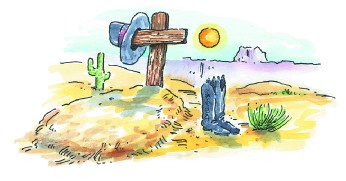In Rome's placid Protestant Cemetery, the remains of poet John Keats rest in a nameless grave that bears an epitaph he wrote himself: "Here lies one whose name was writ in water." Perhaps so, but the names of the dead are more commonly writ in stone, often with an epitaph to send them on their way. During the past three years, Francke professor of German art and culture Karl Guthke has collected and studied epitaphs from around the world and across the centuries for his Epitaph Culture in the West, his exploration of how we memorialize the departed in words. "We're the only life form that knows beforehand that we will die," says Guthke, "and the only one that buries its dead." Or writes epitaphs.
The book will complete Guthke's trilogy of thanatological monographs, including the self-explanatory Last Words and The Gender of Death, which analyzes how cultures imagine death to be female or male. "Cultural history has been my fascination," he says, noting that most of his 24 books plumb the "cultural manifestations of human self-awareness." Guthke has gleaned gravestone material from anthologiescollecting epitaphs has been a human hobby for more than 2,000 yearsand has visited lots of cemeteries, from Paris and London to Punta Arenas, Chile. There, at the tip of South America, he found a headstone with a quotation in German from Goethe's Faust: "So far, and yet so near." Sometimes examples showed up in surprising locations, like the Russian burial ground on the northern California coast for a colony settled there in the early 1800s.
"Ninety percent of epitaphs tend to be roughly the same," Guthke says, "'To the memory of James, who was a good father...,' or, in earlier centuries, 'In expectation of resurrection....' But beginning in the late nineteenth and early twentieth centuries, we tend to see just names and dates. The cemeteries have become rather taciturn. People are avoiding epitaphs entirelybeing cremated and having their ashes scattered, or buried under a flowerbed. If there is a stone, it may read, simply, father, mother, or just the first name. Only the actual family would know who is buried there. The trend has been toward anonymity, although in the 1980s and 1990s there's also been a counter-trend in England and Germany to make the cemetery a place of memoryan instance of 'memory culture.' There has been some movement toward restoring eloquence: quotes from Auden, Neruda, or Indian sacred writings. One stone read, 'Nothing lasts, nothing is lost.' That's something one could easily ponder for awhile."
Dishonesty often attaches to epitaphs, which Ambrose Bierce defined as "an inscription on a tomb showing that virtues acquired by death have a retroactive effect." It was not always thus; in the earlier part of the Christian era it was considered arrogant or even pagan to praise the dead, rather than to pray for their souls. But with the rise of humanism in the fifteenth and sixteenth centuries, the custom began of mentioning worthwhile personal qualities of the deceased. "The epitaph became a summation of that person," says Guthke. Eventually this evolved into fulsome, hyperbolic praise. In 1976, however, the official Anglican Churchyards Handbook declared that epitaphs should not be laudatory.
 |
| Illustration by Lynne Foy |
Suicides were always a separate issue. "For centuries they were buried in open fields with no monuments, or sometimes a monument pointing out the scandal," Guthke says. "Since suicides cannot repent, [people thought] they would go directly to hell. Often they were buried at a crossroads with a stake through the heart to keep the ghost of the suicide from reappearingEngland finally outlawed that practice in 1823. In the twentieth century this all changed; there was far greater acceptance of suicides." Even so, when Jeanne Hébuterne, the wife of painter Amédéo Modigliani, jumped from a window to her death the day after he died in 1920, it took 10 years before she was moved to his side at Père Lachaise Cemetery in Paris.
Despite the somber circumstances, Guthke says, "frequently people say something very funny" in epitaphs (leading some German churchyards explicitly to prohibit irony). Consider John Dryden's epitaph for his spouse: here lies my wife/here let her lie!/now she's at rest, and so am i. Some widows have used headstones to advertise their marriageability. And at the famous animal cemetery in London's Hyde Park, a stone once memorialized a dog named Pompey: one might have thought he was human, but he was loyal. Even in Westminster Abbey, wit appears in the self-authored epitaph of playwright John Gay, who wrote The Beggar's Opera: life is a jest; and all things show it./i thought so once; but now i know it. Verses like this may have fallen out of fashion for economic as well as cultural reasons. "Over the years, the price of letters chiseled in stone has gone up," Guthke says. "You have to be succinct!"
~Craig Lambert




